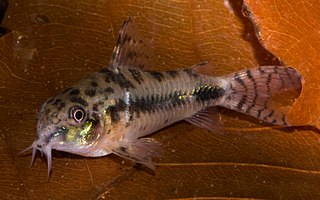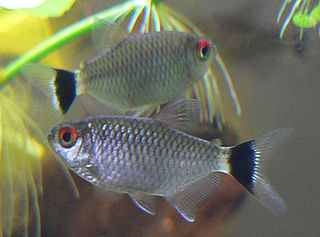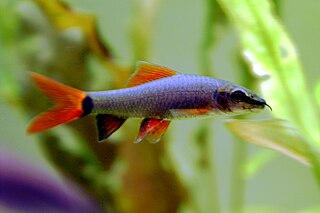
The neon tetra is a freshwater fish of the characin family of order Characiformes. The type species of its genus, it is native to blackwater and clearwater streams in the Amazon basin of South America. Its bright colouring makes the fish visible to conspecifics in the dark blackwater streams, and is also the main reason for its popularity among freshwater fish hobbyists, with neon tetras being one of the most widely kept tropical fish in the world.

The black neon tetra is a freshwater fish of the characin family (Characidae) of the order Characiformes. It is native to the Paraguay basin of southern Brazil. They are often found in the aquarium trade.

The black phantom tetra, or simply phantom tetra, is a small freshwater fish of the characin family (Characidae) of order Characiformes. It is native to the upper Paraguay basin and upper Madeira basin in Brazil and Bolivia. It is commonly seen in the aquarium trade.

The serpae tetra, also known as the red minor tetra, jewel tetra or callistus tetra, is a species of tetra, a tropical freshwater fish of the characin family of order Characiformes. It is native to the Amazon River drainage in Brazil, Peru, Paraguay, Bolivia and northern Argentina. The fish can be found in slow moving or still backwater including, ponds, small lakes, and streams. In the wild, it forms aggregations around vegetation and tree roots, and thrives when the water temperature is 22–27 °C (72–81 °F).

The harlequin rasbora is a small fish in the family Cyprinidae. The species became an instant favorite among aquarists after its introduction in the early 1900s and is the best known and most widely kept species among the rasboras. In 1935, an image of a trio of harlequin rasboras, stamped in 14k gold, would grace the cover of the first edition of William T. Innes's classic Exotic Aquarium Fishes and would remain so through all 19 editions.

Hoplisoma panda, formerly known as Corydoras panda, is a species of catfish belonging to the genus Hoplisoma, of the family Callichthyidae, and is a native member of the riverine fauna of South America. It is found in Peru and Ecuador, most notably in the Huánuco region, where it inhabits the Río Aquas, the Río Amarillae, a tributary of the Río Pachitea, and the Río Ucayali river system. The species was first collected by Randolph H. Richards in 1968, and was named Corydoras panda by Nijssen and Isbrücker in 1971. The specific name is an allusion to the appearance of the fish, which possesses large black patches surrounding the eyes, reminiscent of those found on the giant panda. Accordingly, the common names for this fish are panda corydoras,panda catfish, and panda cory.

The salt and pepper catfish is a tropical freshwater fish belonging to the Corydoradinae sub-family of the family Callichthyidae. It originates in inland waters in South America, and is found in the Upper Orinoco River basin in Venezuela and Colombia.

The lemon tetra is a species of tropical freshwater fish which originates from South America, belonging to the family Characidae. It is a small tetra growing to 5 cm (2 in) in length. The species is a long established favourite aquarium fish, being introduced to the aquarium in 1932.

The rummy-nose tetra is a species of tropical freshwater characin fish originating in South America, popular among fishkeepers as a tropical aquarium fish. One of many small tetras belonging to the same genus, it is on average 5 cm (2 in) long when fully grown. The fish is one of several very similar species including Petitella bleheri, and Petitella georgiae, and it is possible that more recently collected specimens available in the aquarium trade are members of one or other of these similar species. The common name applied to most of these fishes is "rummy-nose tetra", though other common names are in circulation.
The bloodfin tetra is a species of characin from the Paraná River basin in South America. The bloodfin is a relatively large tetra, growing to 5.5 cm. Its notable feature is the blood-red colouration of the tail, dorsal, anal and adipose fin, while the body is silver in color.

The Buenos Aires tetra is a tropical fish from South America. It was first observed in the wild in 1907, by Carl H. Eigenmann.

Hemigrammus erythrozonus, commonly known as the glowlight tetra, is a small tropical fish from the Essequibo River, Guyana, South America. It is silver in colour and a bright iridescent orange to red stripe extends from the snout to the base of its tail, the front of the dorsal fin being the same color as the stripe. Other fins are silver to transparent. The glowlight tetra is a peaceful, shoaling fish. It is larger than the neon tetra, and its peaceful disposition makes it an ideal, and popular, community tank fish. It should be kept with similar sized, non-aggressive species. Hemigrammus gracilis is a senior synonym. The red-line rasbora of Malaysia and Indonesia has markings and coloring very similar to H. erythrozonus, but is a member of family Cyprinidae, not a close relative.

Pelvicachromis pulcher is a freshwater fish of the cichlid family, endemic to Nigeria and Cameroon. It is popular amongst aquarium hobbyists, and is most commonly sold under the name kribensis, although it has other common names, including various derivatives and color morphs of the kribensis: krib, common krib, red krib, super-red krib and rainbow krib, along with rainbow cichlid and purple cichlid.

Mikrogeophagus altispinosus is a species of fish endemic to the southern Amazon River basin in Brazil and Bolivia. The species is part of the family Cichlidae and subfamily Geophaginae. It is a popular aquarium fish, traded under the common names Bolivian butterfly, Bolivian ram, Bolivian ram cichlid, and ruby crown cichlid.

The diamond tetra is a small freshwater fish of the characin family of order Characiformes. It is found in and around Lake Valencia in Venezuela, South America.

The redeye tetra, is a species of tetra from the São Francisco, upper Paraná, Paraguay and Uruguay river basins in eastern and central South America. This freshwater fish is commonly kept in aquariums and bred in large numbers at commercial facilities in Eastern Europe and Asia. The redeye tetra is one of the more popular aquarium fish due to their schooling capability.

The rainbow shark is a species of Southeast Asian freshwater fish from the family Cyprinidae. It is also known as the ruby shark, red-fin shark, red-finned shark, rainbow sharkminnow, green fringelip labeo, whitefin shark and whitetail sharkminnow. It is a popular, semi-aggressive aquarium fish. Unlike true sharks, which belong to the Chondrichthyes lineage, the rainbow shark is an actinopterygiian.

The White Cloud Mountain minnow is a hardy species of freshwater fish and coldwater fish often kept in an aquarium. The species is a member of the carp family of the order Cypriniformes, native to China. The White Cloud Mountain minnow is practically extinct in its native habitat, due to pollution and tourism. It was believed to be extinct for over 20 years in 1980, but an apparently native population of this fish was discovered on Hainan Island, well away from the White Cloud Mountain. They are bred in farms and are easily available through the aquarium trade. However, inbreeding in farms has led to genetically weak stock that is vulnerable to disease and prone to physical deformities.

The Odessa barb is a species of cyprinid fish known from Central Myanmar, where it is known to occur in an artificial pond above the Anisakan Falls and also from the lower Chindwin River. For many years it has been known to the aquarium hobby, where it has frequently been confused with the less colourful ticto barb, but it was only described scientifically in 2008.

Hemigrammus ocellifer is a South American freshwater fish, also known by the Common names of beacon fish, beacon tetra, head-and-tail light tetra and head-and-taillight tetra. It is found in the rivers of Guyana, Suriname, French Guiana, and the Amazon Basin of Brazil and Peru.




















